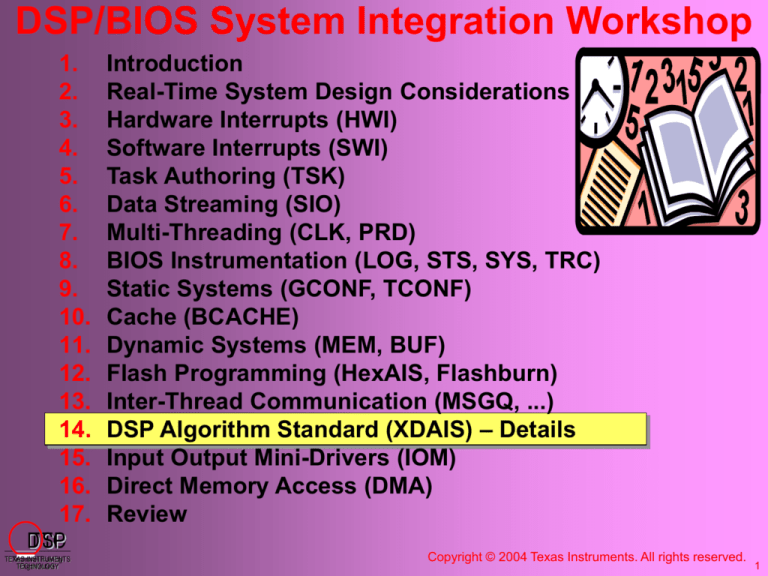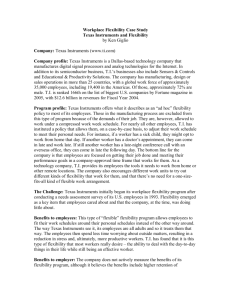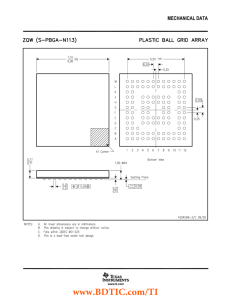
DSP/BIOS System Integration Workshop
1.
2.
3.
4.
5.
6.
7.
8.
9.
10.
11.
12.
13.
14.
15.
16.
17.
TO
DT SP
TEXAS
Technical
INSTRUMENTS
Training
TECHNOLOGY
Organization
Introduction
Real-Time System Design Considerations
Hardware Interrupts (HWI)
Software Interrupts (SWI)
Task Authoring (TSK)
Data Streaming (SIO)
Multi-Threading (CLK, PRD)
BIOS Instrumentation (LOG, STS, SYS, TRC)
Static Systems (GCONF, TCONF)
Cache (BCACHE)
Dynamic Systems (MEM, BUF)
Flash Programming (HexAIS, Flashburn)
Inter-Thread Communication (MSGQ, ...)
DSP Algorithm Standard (XDAIS) – Details
Input Output Mini-Drivers (IOM)
Direct Memory Access (DMA)
Review
Copyright © 2004 Texas Instruments. All rights reserved.
1
Learning Objectives
Describe how users specify algorithm behaviour
Describe how users control RAM and ROM usage
Show how XDAIS algorithms support multiple instances
List the interface methods employed by xDAIS algorithms
List the API chronology in using xDAIS algorithms
Describe how xDM extends the xDAIS standard
Use Component Wizard to develop an XDAIS interface
D SP
TEXAS INSTRUMENTS
TECHNOLOGY
2
xDAIS and xDM Authoring
Instance Creation Parameters
Data Memory Management
Program Memory Management
Multi-Instance Ability
xDAIS = Static or Dynamic
xDAIS Chronological Flow
XDM – xDAIS for Digital Media
D SP
TEXAS INSTRUMENTS
TECHNOLOGY
3
The Param Structure
Purpose : To allow the application to specify to the algorithm
the desired modes for any options the algorithm allows, eg:
size of arrays, length of buffers, Q of filter, etc…
sizeof()
Defined by :
filterType
filterOrder
Algorithm
(in header file)
Allocated by :
Application
bufferSize
...
Written to by : Application
...
Read from by : Algorithm
D SP
TEXAS INSTRUMENTS
TECHNOLOGY
4
Param Structures Defined in IMOD.H
// IFIR_Params - structure defines instance creation parameters
typedef struct IFIR_Params {
Int size;
/* 1st field of all params structures */
XDAS_Int16
firLen;
XDAS_Int16
blockSize;
XDAS_Int16 *
coeffPtr;
} IFIR_Params;
// IFIR_Status - structure defines R/W params on instance
typedef struct IFIR_Status {
Int
size;
XDAS_Int16
blockSize;
XDAS_Int16 *
coeffPtr;
/* 1st field of all status structures */
} IFIR_Status;
D SP
TEXAS INSTRUMENTS
TECHNOLOGY
5
IFIR_Params : IFIR.C
#include <std.h>
#include "ifir.h"
IFIR_Params IFIR_PARAMS = {
sizeof(IFIR_Params),
32,
1024,
0
};
Defines Parameter Defaults
Length of Structure
Filter Length
Block Size
Coefficient Pointer
User may replace provided IFIR.C defaults with their preferred defaults
After defaults are set, Params can be modified for instance specific behavior
#include "ifir.h"
IFIR_Params IFIR_params ;
IFIR_params = IFIR_PARAMS;
IFIR_params.firLen = 64;
IFIR_params.blockSize = 1000;
Create a Param structure
Put defaults in Param structure
Override length parameter
Override block size parameter
D SP
TEXAS INSTRUMENTS
TECHNOLOGY
6
xDAIS and xDM Authoring
Instance Creation Parameters
Data Memory Management
Program Memory Management
Multi-Instance Ability
xDAIS = Static or Dynamic
xDAIS Chronological Flow
XDM – xDAIS for Digital Media
D SP
TEXAS INSTRUMENTS
TECHNOLOGY
7
The MemTab Transaction
Params
sizeOf
*coeffPtr
filterLen
frameLen
memTab
2
1
Algorithm
• Knows memory requirements
• Requests appropriate resources
from Application
Application (Framework)
• Manages memory requests
• Determines what memories are
available to which algorithms and when
5
D SP
TEXAS INSTRUMENTS
TECHNOLOGY
6
Physical Memory
“space”:
External (slow, plentiful, less cost)
Internal (fast, limited, higher cost)
SARAM, DARAM
3
8
4
7
size
alignment
space
attrs
address0
size
alignment
space
attrs
address1
size
alignment
...
8
The MemTab Structure
Purpose : Interface where the algorithm can define its
memory needs and the application can specify the base
addresses of each block of memory granted to the algorithm
size
alignment
space
attrs
*base
size
alignment
space
attrs
*base
...
...
Defined by :
IALG Spec & Algorithm
(rtn value of algNumAlloc)
Allocated by :
Application
5*algNumAlloc()
Written to by : Algorithm (4/5) &
Application (base addrs)
Read from by : Application (4/5) &
Algorithm (base addrs)
D SP
TEXAS INSTRUMENTS
TECHNOLOGY
9
Key Framework (eg DSKT2) Code
Determine number of buffers required
n = fxns->ialg.algNumAlloc();
Build the memTab
memTab = (IALG_MemRec *) MEM_alloc(0, n*sizeof(IALG_MemRec), 0);
Inquire buffer needs from algo
n = fxns->ialg.algAlloc((IALG_Params *)params,&fxnsPtr,memTab);
Allocate memory for algo
for (i = 0; i < n; i++) {
memTab[i].base = (Void *)MEM_alloc(memTab[i].space, memTab[i].size, memTab[i].alignment);
}
Set up handle, *fxns pointer, initialize instance object
alg = (IALG_Handle)memTab[0].base;
alg->fxns = &fxns->ialg;
fxns->ialg.algInit(alg, memTab, NULL, (IALG_Params *)params)
Free the memTab & return the handle to the newly created instance object
MEM_free(0, memTab, n*sizeof(IALG_MemRec));
return ((IFIR_Handle)alg);
D SP
TEXAS INSTRUMENTS
TECHNOLOGY
10
xDAIS and xDM Authoring
Instance Creation Parameters
Data Memory Management
Program Memory Management
Multi-Instance Ability
xDAIS = Static or Dynamic
xDAIS Chronological Flow
XDM – xDAIS for Digital Media
D SP
TEXAS INSTRUMENTS
TECHNOLOGY
11
The vTab Concept and Usage
#include <ialg.h>
typedef struct IFIR_Fxns {
IALG_Fxns ialg; /* IFIR extends IALG */
Void (*filter)(IFIR_Handle handle, XDAS_Int8 in[],XDAS_Int8 out[]);
} IFIR_Fxns;
instance
handle
fxns
Key:
User
Vendor
Module
XDAIS
IFIR_Fxns
alg ...
alg ...
algInit
alg …
filter
…
Program Memory
...
…
FIR_TTO_initObj
…
FIR_TTO_filter
…
hFir->fxns=&FIR_TTO_IFIR;
hFir->fxns->ialg.algInit((IALG_Handle)hFir, memTab,NULL,(IALG_Params *)&firParams);
hFir->fxns->filter(hFir,processSrc,processDst);
D SP
TEXAS INSTRUMENTS
TECHNOLOGY
12
vTab Structure
typedef struct IALG_Fxns {
Void *implementationId;
Void (*algActivate)
(...);
Int
(*algAlloc)
(...);
Int
(*algControl)
(...);
Void (*algDeactivate) (...);
Int
(*algFree)
(...);
Int
(*algInit)
(...);
Void (*algMoved)
Int
(...);
(*algNumAlloc) (...);
} IALG_Fxns;
D SP
TEXAS INSTRUMENTS
TECHNOLOGY
13
Pragmas - For Linker Control of Code
Sections
#pragma
#pragma
#pragma
#pragma
#pragma
#pragma
#pragma
#pragma
CODE_SECTION(FIR_TTO_activate, ".text:algActivate")
CODE_SECTION(FIR_TTO_alloc,
".text:algAlloc")
CODE_SECTION(FIR_TTO_control,
".text:algControl")
CODE_SECTION(FIR_TTO_deactivate, ".text:algDeactivate")
CODE_SECTION(FIR_TTO_free,
".text:algFree")
CODE_SECTION(FIR_TTO_initObj,
".text:algInit")
CODE_SECTION(FIR_TTO_moved,
".text:algMoved")
CODE_SECTION(FIR_TTO_numAlloc, ".text:algNumAlloc")
#pragma CODE_SECTION(FIR_TTO_filter,
".text:filter")
D SP
TEXAS INSTRUMENTS
TECHNOLOGY
14
Linker Control of Code Sections
Users can define, with any degree of specificity, where particular algo
components will be placed in memory
.text:algActivate
.text:algDeactivate
.text:filter
.text
>
>
>
>
IRAM
IRAM
IRAM
SDRAM
Components not used may be discarded via the “NOLOAD” option
.text:algActivate
.text:algDeactivate
.text:filter
.text:algAlloc
.text:algControl
.text:algFree
.text:algMoved
.text:algNumAlloc
.text
>
>
>
>
>
>
>
>
>
IRAM
IRAM
IRAM
SDRAM,
SDRAM,
SDRAM,
SDRAM,
SDRAM,
SDRAM
type
type
type
type
type
=
=
=
=
=
NOLOAD
NOLOAD
NOLOAD
NOLOAD
NOLOAD
D SP
TEXAS INSTRUMENTS
TECHNOLOGY
15
xDAIS and xDM Authoring
Instance Creation Parameters
Data Memory Management
Program Memory Management
Multi-Instance Ability
xDAIS = Static or Dynamic
xDAIS Chronological Flow
XDM – xDAIS for Digital Media
D SP
TEXAS INSTRUMENTS
TECHNOLOGY
16
The Instance Object Structure
Purpose : To allow the application to specify to the algorithm
the desired modes for any options the algorithm allows, eg:
size of arrays, length of buffers, Q of filter, etc…
*fxns
Defined by :
Algorithm
Allocated by :
Application
filterLen
blockSize
*coeffs
*workBuf
via memRec(0) description
Written to by : Algorithm
...
...
Read from by : Algorithm
(private structure!)
D SP
TEXAS INSTRUMENTS
TECHNOLOGY
17
XDAIS Instance
EX_TI_Obj
handle
*EX_TI_Fxns
*a
vTab
algo
coeff[32]
code
*x
x[1031]
memTab
...
...
x
...
+
params
D SP
TEXAS INSTRUMENTS
TECHNOLOGY
18
Multiple Instances of an Algorithm
instObj1
handle1
*fxns
*a
handle2
Uniquely named
handles allow
control of
individual
instances of
the same
algorithm
algo
Coeffs
code
*tmp
*hist
Allocate, Activate
as many
instances as
desired
vTab
Scratch1
...
instObj2
*fxns
history1
*a
*tmp
Scratch2
*hist
history2
All instance objects
point to
the same vtab
Coefficient array
can be shared
Scratch can be
separate or
common as
desired
D SP
TEXAS INSTRUMENTS
TECHNOLOGY
19
xDAIS and xDM Authoring
Instance Creation Parameters
Data Memory Management
Program Memory Management
Multi-Instance Ability
xDAIS = Static or Dynamic
xDAIS Chronological Flow
XDM – xDAIS for Digital Media
D SP
TEXAS INSTRUMENTS
TECHNOLOGY
20
Static vs. Dynamic Algorithms
“Normal” (static) C Coding
“Dynamic” C Coding
#define SIZE 32
#define SIZE 32
int x[SIZE];
/*allocate*/
Create
a=malloc(SIZE);
int a[SIZE];
x={…};
x={…};
/*initialize*/
a={…};
a={…};
filter(…);
x=malloc(SIZE);
/*execute*/
Execute
filter(…);
Delete
free(x);
free(a);
D SP
TEXAS INSTRUMENTS
TECHNOLOGY
While DaVinci is a fully dynamic system, xDAIS was
designed to support either static or dynamic systems
21
Support for Static & Dynamic Instances
Static *
Algorithm
Dynamic
Framework
Algorithm
Create
algNumAlloc
algAlloc
algInit
algInit
Execute
algActivate
Filter
algDeactivate
Filter
Delete
algFree
*Note: Static case would also invoke “algActivate” if algo uses “scratch” memory
D SP
TEXAS INSTRUMENTS
TECHNOLOGY
22
xDAIS and xDM Authoring
Instance Creation Parameters
Data Memory Management
Program Memory Management
Multi-Instance Ability
xDAIS = Static or Dynamic
xDAIS Chronological Flow
XDM – xDAIS for Digital Media
D SP
TEXAS INSTRUMENTS
TECHNOLOGY
23
Instance Creation - start
Application
Framework
Algorithm
1. Here’s the way I want
you to perform…
*params = malloc(x);
params=PARAMS;
2. How many blocks of
memory will you need
to do this for me?
Params
algNumAlloc()
N
4. I’ll make a place where
you can tell me about
your memory needs…
*memTab = malloc(5*N)
3. I’ll need “N” blocks
of memory to do what
you’ve specified…
MemTab
D SP
TEXAS INSTRUMENTS
TECHNOLOGY
24
Instance Creation - finish
Application
Framework
5. Tell me about your
memory requirements…
Algorithm
algAlloc()
Params
MemTab
7.I’ll go get the memory
you need…
for(i=0;i<=N;i++)
base=malloc(size);
8. Prepare an instance
to run!
size
alignment
space
attrs
*base
N
algInit()
6. My needs, given these
parameters, are this,
for each of the N
blocks of memory
InstObj
Param1
Param2
…
Base1
Base2
…
9. Copy Params and
memory bases into
my instance object…
D SP
TEXAS INSTRUMENTS
TECHNOLOGY
25
Instance Execution
Application
Framework
1. Get ready to run.
Scratch memory is
yours now.
3. Run the algorithm …
5. I need the scratch block
back from you now…
Algorithm
algActivate()
runDSP()
algDeactivate()
2. Prepare scratch
memory, as required,
from persistent
memory
4. Perform algorithm freely using all
memory resources
assigned to algo
6. Save scratch elements
to persistent memory
as desired
D SP
TEXAS INSTRUMENTS
TECHNOLOGY
26
Instance Deletion
Application
Framework
If I no longer need the
algorithm:
1. I’ll make a memTab
again, or reuse the
prior one
*memTab = malloc(5*N)
2. What memory resources
were you assigned?
4. free all persistent
memories recovered
from algorithm
Algorithm
MemTab
InstObj
size
alignment
space
attrs
*base
Param1
Param2
…
Base1
Base2
…
algFree()
3. Re-fill memTab using
algAlloc and base
addresses stored in the
instance object
D SP
TEXAS INSTRUMENTS
TECHNOLOGY
27
xDAIS and xDM Authoring
Instance Creation Parameters
Data Memory Management
Program Memory Management
Multi-Instance Ability
xDAIS = Static or Dynamic
xDAIS Chronological Flow
XDM – xDAIS for Digital Media
D SP
TEXAS INSTRUMENTS
TECHNOLOGY
29
xDAIS Limitations
xDAIS defines methods for managing algo heap memory :
algCreate, algDelete, algMoved
xDAIS also defines methods for preparation/preservation of scratch
memory : algActivate, algDeactivate
Does not define the API, args, return type of the processing method
Does not define the commands or structures of the control method
Does not define creation or control structures
Reason: xDAIS did not want to stifle options of algo author
and Yields unlimited number of potential algo interfaces
For DaVinci technology, defining the API for key media types would
greatly improve
Usability
Modifiability
System design
As such, the digital media extensions for xDAIS “xDAIS-DM” or
“xDM” has been created to address the above concerns in DaVinci
technology
Reduces unlimited possibilities to 4 encoder/decoder sets !
30
xDAIS
If given a packaged algo (only object code), what would you need to know to use it?
Need to Know
“Packaged” Algo
What config options
do I have?
Algorithm
Parameters
“xDAIS” functions
Functions to call
Memory Usage
Performance
D SP
TEXAS INSTRUMENTS
TECHNOLOGY
my DSP functions
Memory
Description Table
Filter Example
Params =
Tap Size
Block Size
Coeff’s
create/delete
func’s
doFilter()
(aka iAlg)
(aka iMod)
Inst Obj
block
history
.PDF
31
xDAIS-DM (xDM)
If given a packaged algo (only object code), what would you need to know to use it?
Need to Know
What config options
do I have?
Functions to call
Memory Usage
Performance
D SP
TEXAS INSTRUMENTS
TECHNOLOGY
“Packaged” Algo Video Decoder Example
Height
Width
FrameRate
BitRate, …
Algorithm
Parameters
“xDAIS” functions
create/delete
func’s
my DSP functions
process(), control()
Memory
Description Table
.PDF
(aka iAlg)
Inst Obj
block
history
What do you mean,
"fixed" params?
32
xDM Interfaces
xDM
IVID_ENC
IVID_DEC
IAUD_ENC
IAUD_DEC
8 classes:
4 algo domains V I S A
2 functionalities Enc, Dec
ISPH_ENC
ISPH_DEC
IIMG_ENC
IIMG_DEC
Enable plug + play ability for multimedia codecs across implementations / vendors / systems
Uniform across domains…video, imaging, audio, speech
Flexibility of extension of custom / vendor-specific functionality
Low overhead
Insulate application from component-level changes
Hardware changes should not impact software (EDMA2.0 to 3.0,….)
PnP …enable ease of replacement for versions, vendors
Framework Agnostic
Integrate component into any framework
Enable early and parallel development by publishing the API: create code faster
System level development in parallel to component level development
Reduce integration time for system developers
Published and Stable API
TI, 3Ps, and Customers
Support Backward Compatibility
33
Technical Training
Organization
ti
34









